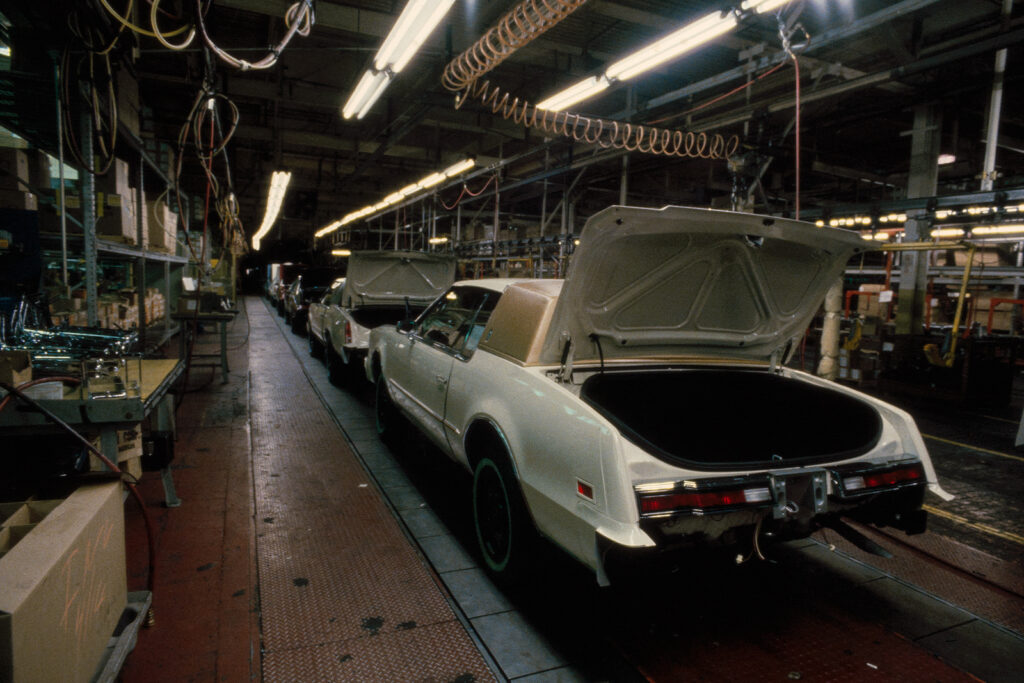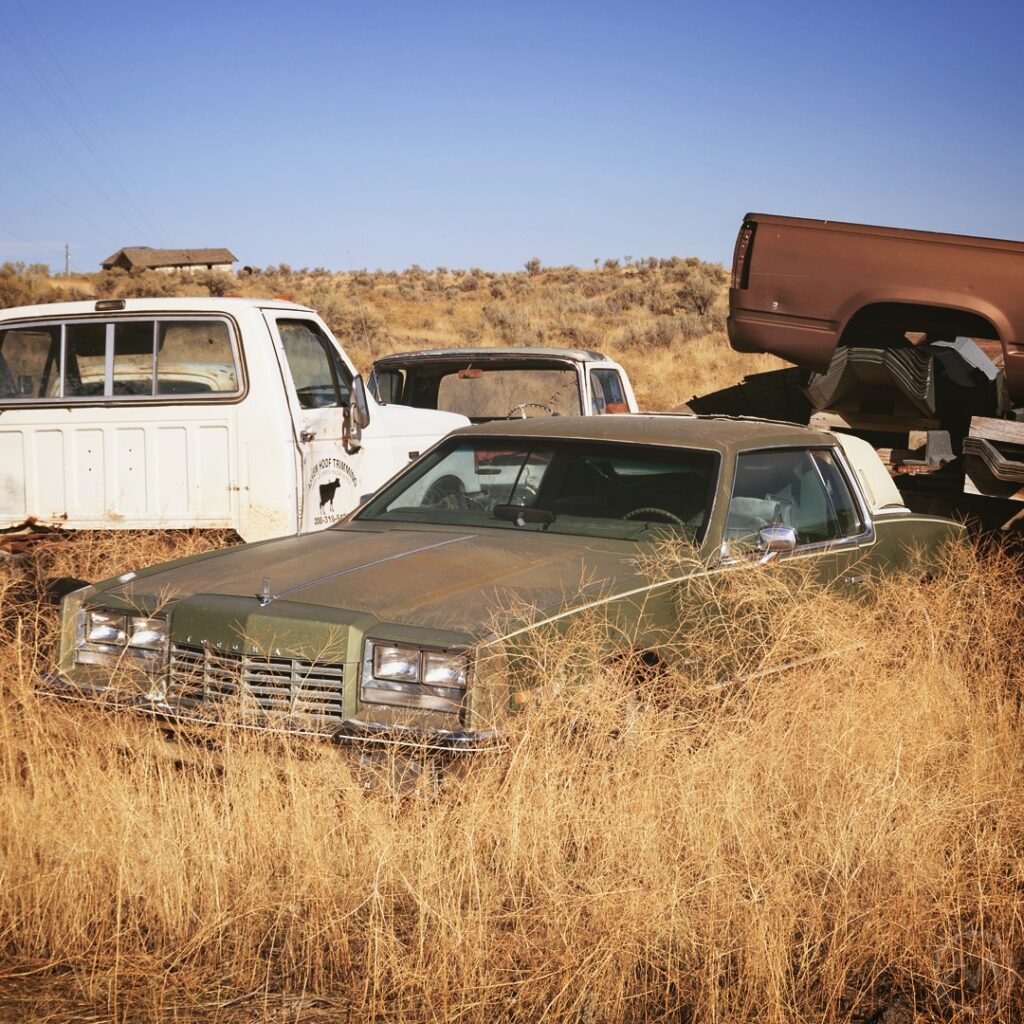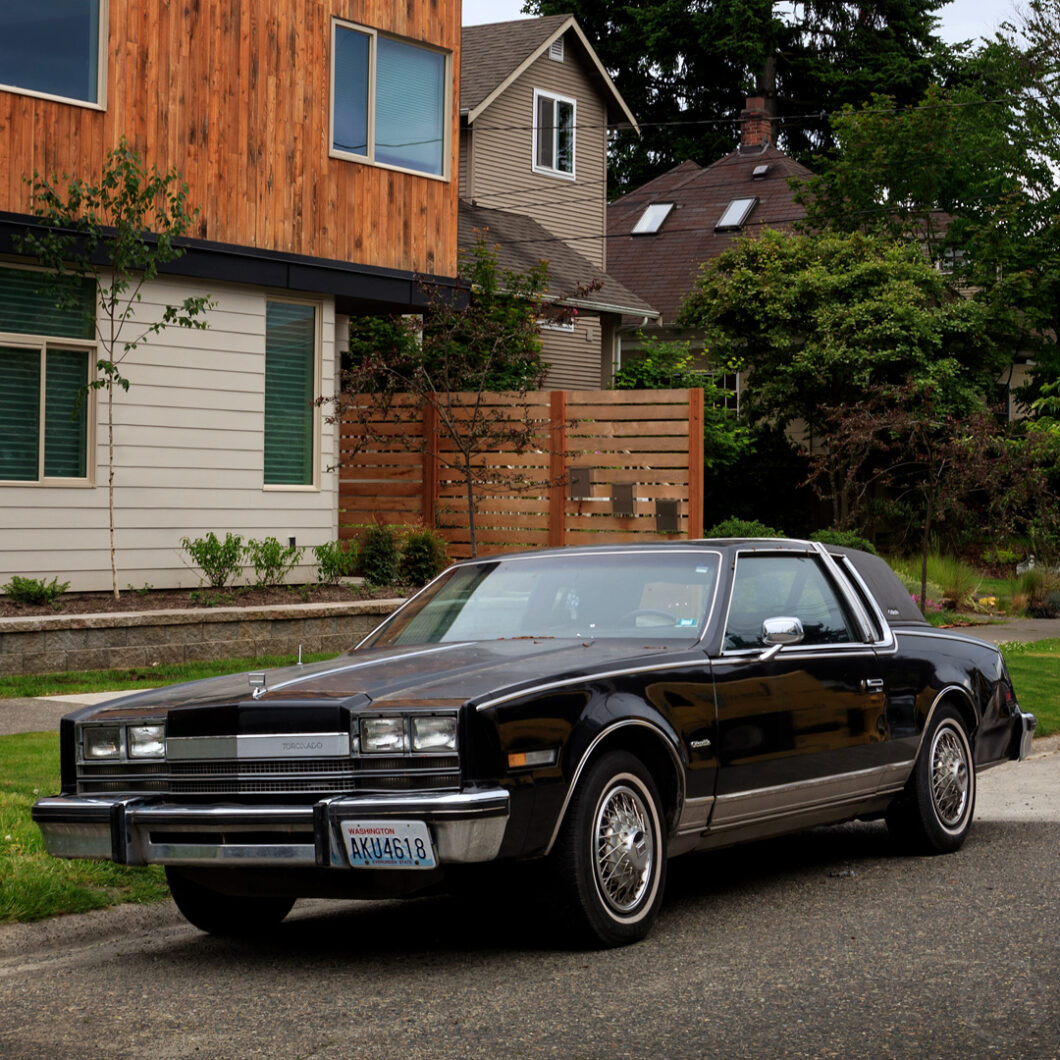Most of the time, when car enthusiasts picture an Oldsmobile Toronado, it’s the daring original version that bowed in the fall of 1965. That sleek machine, the first front-drive American car in 30 years at the time, is a design classic. Some might also picture the last Toronado — the 1990-92 Troféo; a dark horse collector car that appeals to a different generation than the original. However, in terms of actual success with buyers, the Toronado’s best years were those in the middle, the jumbo-sized second-generation 1971-78 model and the downsized 1979-85 version.
The radical change between these two Toros was the direct result of the 1973 OPEC crisis, but the formula was more or less perfected. The vast ’73 Toronado, conceived in the era when dynamic, engineering-minded manager John Beltz ran the rocket division, was the most popular single model year in the Toronado’s history, with 55,921 cars sold. Then the fuel crisis sent sales of land yachts sliding. The Cadillac Eldorado and Lincoln Continental MkIV survived well enough, as their buyers weren’t as price or fuel conscious, but the Toronado was hit hard.
Despite Oldsmobile’s domination of the mid-price car market in the 1970s and the re-emergence of some big-car buyers by 1976, the Toronado didn’t recover until it was downsized for 1979. At the same time, GM finally put all three of its specialty premium cars on one single platform.
Evolution of the E
All through the 1970s, General Motors gradually began rationalizing its far-flung manufacturing operations and ever-increasing number of models. The General’s big personal luxury cars had taken circuitous routes to arrive at similar conclusions. Buick’s Riviera debuted first, after Cadillac and Chevrolet had turned down the concept that led to that car. Olds and Buick then competed for it and Olds lost. But the Riviera on its own was an expensive car to build, which prompted GM to greenlight companions from Olds and Cadillac, on what became the “E-Body.”
But the Olds and Cadillac versions would use front-wheel drive, then a mechanical novelty confined mainly to small European cars and best remembered in America as one of Cord’s main claims to fame. Front wheel drive cars were so unusual in the 1960s that there were actually enthusiast clubs for them, though that did not last very long.
The goal was market differentiation and innovation, not necessarily fuel efficiency, but Olds was the primary driver of developing what became the “Unitized Power Package.” This setup, engineered by Howard Kehrl and Jim Lewis at Oldsmobile, working under future Oldsmobile boss John Beltz, mated the big Olds Rocket V8 with a turbo hydramatic transmission in dramatic fashion. The engine was offset slightly to the driver’s side, with the gearbox slung alongside and connected to the engine and torque converter via a beefy chain drive.
It was relatively compact for the size of the engine and allowed for a very low hood. Better still, it was adaptable to other engines. At the time it was being created, Cadillac was planning a V-12 unit for the Eldorado, though that engine never materialized. The UPP was something that could be adapted to other vehicles, and it even ended up serving in GMC’s motorhomes, but for much of its existence the only cars it was used in were the Eldorado and Toronado. The idea of unifying the three big luxury coupes on a single platform was a good one, but that did not happen for a long time.

The New Jersey Mafia
Instead, Buick put the second- and third-gen Rivieras on the B-body chassis (despite initially wanting to migrate it to an A/G body car) while Cadillac and Olds redesigned their E-cars in 1971 to be even larger but not all that different mechanically. Then came OPEC and the need for real rationalization, as well as Cadillac’s next project, the Seville. The goal for the end of the 1970s was unifying all these cars onto a single new E-body platform to be built in a single plant. That would make all four cheaper to build and streamline the supply chain.
New Jersey’s Linden Assembly, just 15 minutes from Newark Airport, got the nod. This plant dated back to 1937 and had manufactured many Buick, Oldsmobile, and Pontiac models over the decades. In 1971, it became the first plant outside of Michigan to build Cadillacs, churning out DeVilles for the Northeast and mid-Atlantic regions. At the time, GM’s various plants had plenty of quality ills, but the cars coming out of Linden were among the most reliable and well-made in the family. It was a natural choice to build pricey cars for demanding luxury customers.
For the first time, all three cars would ride the same E-body platform, with the Riviera adapting a downsized version of the UPP. A year later, the Seville would join them on the very similar K-body platform, the only four-door variation. The biggest change was probably to the Riviera, which had spent the previous two years as a frillier version of the Buick LeSabre.
Jokes aside, there’s no actual Mafia connection here even if local mobsters in Linden and nearby Elizabeth later inspired the fictional DiMeo crime family from The Sopranos. The E-body cars, however, were hugely popular with buyers and ended up being regularly used in film to depict what 1980s mafiosi drove.
These new E-cars represented the third wave of GM’s downsizing program, following the biggest cars (B/C) in 1977 and the midsize machines (A/G) in 1978. All front-drivers, they shared a common transaxle, essentially a slightly updated version of the original Toronado’s “Unitized Power Package” setup, the adapability of which proved invaluable since the package had to be adapted to many different engines in this period.

Peak Toronado
As with the later visual refreshes of the gigantic 1971-78 Toronado, the downsized ‘79 was styled under the direction of Len Casillo. As before, looked and felt very much like the Eldorado, but it came at a lower price point. There were also mechanical differences that, in the ensuing years, would make the Toronado a better vehicle overall than it’s Cadillac sister.
The new E-car was truly downsized: 22 inches (56 cm) shorter overall and 900 lbs. (408 kg) lighter than before, but it didn’t feel or look “small,” particularly from behind the wheel where the lengthy hood seemed to stretch out forever, just as before. The interior was also just as large as in the car’s huge predecessor, so nobody complained about the new dimensions. All three of the E-coupes looked good, although the Toro may have been the least distinctive of them.
At first, the new Toro’s front fascia was closely linked to the outgoing 1978 Toronado, but unlike the other two E-body coupes, in 1980 the Toronado got a hastily-created new front face that harked back to the famous ‘66, with a Cord-like look and delicate horizontal lines with a more low-profile air intake.
In the mid-1970s, before the downsized E-bodies were properly in the design process, a more Cord-like Toro had been contemplated, but it never made it to production. It’s possible that the changes for 1980 were an attempt to incorporate a little more of that idea. They needn’t have bothered. Buyers snapped up over 50,000 Toronados that year, making 1979 the Toros second-best ever year.
Sales remained strong throughout the run, finishing at just over 42,100 units for 1985, despite some weakness in 1982 and 1983.
The trio were still big “personal luxury” barges of the old school, with ride prioritized over handling, though the lighter weight made them more controllable. Rivieras had a more aggressive suspension and Turbocharged V6s, making them the enthusiasts’ choice if only by a little; but Eldos and Toros were smooth boulevardiers. Toros were primarily powered by the Oldsmobile 350 (Gas in ’79/’80 and Diesel throughout) and later 307 (Gas) V8s, with an optional – but very rarely seen – Buick 4.1L V6 from 1981-84.

Early on, the Eldo shared Oldsmobile’s gas 350, but switched to Cadillac’s 368 V8 in 1980. Olds’ 307 proved a huge boon to the Toronado. While Cadillac struggled mightily with the Eaton-supplied V-4-6-8 system in 1981 and the sluggish, trouble-prone HT4100 V8 thereafter, Oldsmobile offered the same basic car with a reliable and torquier engine for less money. This no doubt helped sales, but the Toronado’s total fell from a healthy 42,604 in 1981 to 33,928 in 1982.
To keep the car fresh in the face of that slight slump, an option package (RPO Code WJ8) called the Toronado Caliente was added for 1984. It included a thick B-pillar (all of these cars had resembled hardtops, but the rear windows were fixed), a fat chrome “tiara band” and some extra luxury touches including a primitave version of automatic climate control, a leather steering wheel and a digital dash. 5,007 Calientes were built that year and another 7,342 more in 1985.
Oldsmobile did not offer a convertible Toronado even though Cadillac and Buick decided to introduce droptop versions of the Eldorado and Riviera. A few custom convertibles were made by coachbuilder Hess & Eisenhardt and dealers were happy to sell them, but when it came to spicing up the lineup, the Caliente was as hot as it got.
Both 1984 and 1985 were good years for the Toro, with 48,100 and 42,185 cars sold, respectively, but by then the end was near for the New Jersey E-bodies.
In 1980 and 1981, amid a double-dip recession and record gas prices, GM had decided to double down on downsizing and had ordered a further shrink for the B, C, and E body cars. For the Es, that new design arrived in 1986 to disastrous results. The new cars were too small, too similar to one another, and too much like the smaller (and far cheaper) “formal roof” N-body cars near the lower end of GM’s product ladder.
That big shrink led to a similarly large dropoff in consumer interest and Toronado sales fell to just 15,000 units). That led to a quickie program to restyle them, with the Eldorado and Seville getting top priority, then the Riviera, and finally the Toronado in 1990, when it morphed into the Troféo. The change came too late to revive interest, and the Troféo was belatedly replaced by the very different Aurora in 1994.
1979-85 Oldsmobile Toronado Sales Totals:
- 1979: 50,056
- 1980: 43,440
- 1981: 42,604
- 1982: 33,928
- 1983: 39,605
- 1984: 48,100 (including 5,007 Calientes)
- 1985: 42,185 (including 7,342 Calientes)
- Total: 299,918

